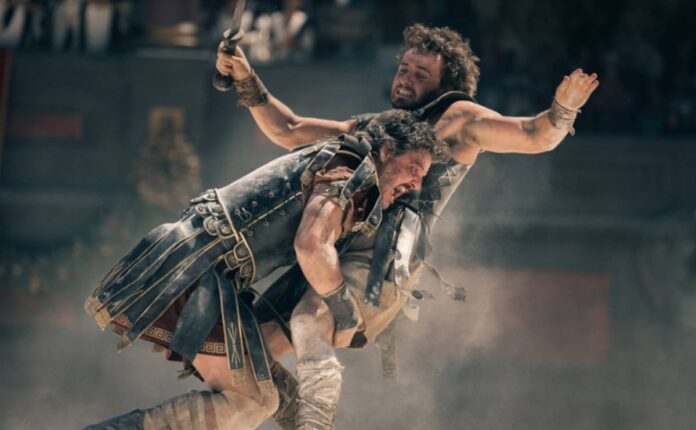Stephan Blum & Michael La Corte/The Conversation
Twenty-four years after Gladiator, Ridley Scott has returned with a sweeping sequel to his epic tale. Thanks to cutting-edge CGI, Rome’s grandeur – and its downfall – have never looked so breathtaking.
Warning: this article contains spoilers for Gladiator II.
Gladiator II picks up years after the original film, taking place during the reign of the co-emperors Caracalla (played by Fred Hechinger) and Geta (Joseph Quinn) in the early 3rd century AD. The film follows Lucius (Paul Mescal), the son of Russell Crowe’s Maximus (protagonist of the first Gladiator movie). Now an adult, he’s been living in the ancient northwest African kingdom, Numidia, under the guise of a new identity to escape Roman politics.
When Roman forces, led by Tribun Marcus Acacius (Pedro Pascal), invade Numidia, tragedy strikes. Lucius’s wife is killed and he is captured. Purchased as a slave by the Roman Macrinus (portrayed masterfully by Denzel Washington), Lucius is transported to Rome. There he is forced into the brutal world of gladiatorial combat, fighting to bring his captor profit in the arena.
But which of these characters were based on real ancient people – and how far did their fates match the arc they have in Scott’s sequel?
The opening invasion scene in Numidia, set in 200 AD, diverges from the real history. After Julius Caesar’s victory at the Battle of Thapsus in 46 AD, Numidia (modern-day Algeria) was divided. The eastern part formed the province Africa Nova and the western region around Cirta became a Roman colony. By the early 3rd century AD, the Roman emperor Septimius Severus (not depicted in the film) made Numidia an independent province.
The film’s portrayal of a rebellious Numidian city seems more like a playful nod to the French comic series Asterix and Obelix, where a small village defies Roman domination. Instead of reflecting the complexities of Roman imperialism, the film adopts the trope of a tiny, indomitable group holding out against an empire in a heavily fortified harbor city.
This blending of myth and history evokes a comic strip sensibility rather than a serious historical narrative, prioritizing spectacle over accuracy.
History Rewritten for the Big Screen
Set in 200 AD, the film places Caracalla and Geta at the center of political intrigue. This is despite the fact that the real imperial heirs were still only children, around nine and ten years old at the time.
Portraying the young boys as cunning political operators is a stretch that even the most imaginative screenwriter might struggle to defend. Furthermore, in 200 AD, their father, Septimius Severus, was still very much alive and in control of the empire, continuing his rule for another 11 years.
Then there is Lucilla (Connie Nielsen), the second daughter of Marcus Aurelius. The film casts her in a prominent role though, inconveniently, in real life she had been executed around 181 or 182 AD – nearly two decades before the events of Gladiator II.
The portrayal of Macrinus is another historical misstep. Although he rose to power under Septimius Severus and Caracalla, Macrinus did not become emperor until 217 AD.
Denzel Washington plays Macrinus in the film. (YouTube Screenshot)
The film dramatizes Macrinus’s role by showing him guiding Caracalla in Geta’s murder and even directly assassinating Caracalla in the Circus Maximus, adding a fictional layer to historical events. But in fact, while Macrinus was involved in the conspiracy to eliminate Caracalla, he did not physically kill the emperor himself.
Historical accounts such as those by Cassius Dio or Historia Augusta do not support the movie’s portrayal of Macrinus stabbing Caracalla in such a public setting.
Caracalla was actually murdered in 217 AD during a journey from Edessa in Turkey to Carrhae in Syria. The assassin, a soldier named Martialis, struck Caracalla with a fatal blow, reportedly at the behest of Macrinus’ supporters, who sought to elevate him to the throne.
Leaving aside the inaccurate timeline, the film is an opulent portrayal of Roman lifestyle in the mid-imperial period. With impressive battle scenes, gladiator duels, grand festivities and stunning costumes, there’s still plenty to enjoy, even for the most fastidious history buff.
Top image: Pedro Pascal plays General Acacius and Paul Mescal plays Lucius in Gladiator II from Paramount Pictures. Source: Aidan Monaghan/Paramount Pictures
This article was originally published under the title ‘Gladiator II: historians on the fate of the real Roman royalty featured in the film’ by Stephan Blum & Michael La Corte on The Conversation, and has been republished under a Creative Commons License.




